The Importance of Telemedicine to Home Health Amid the COVID-19 Outbreak
There is a difference between telehealth and telemedicine. They are both areas of home healthcare that have been recently expanded for the purpose of allowing physicians to utilize the internet to deliver medical care to their patients without having to see them in person. Video visits and remote tools make it possible for the doctor and the patient to communicate remotely.
Telehealth is a scope of medicine covering an array of interactions between the clinician and patient remotely and electronically such as remote blood pressure monitoring. Telemedicine applications are more focused and make it possible for specialists such as cardiologists and wound care physicians to assess and treat their patients remotely.
The Covid-19 pandemic has prompted a drastic change in the United States healthcare system. Recent headlines have erupted with the expansion of Medicare coverage by the federal government to include telemedicine to control the spread of the virus to at-risk patients and clinicians alike. The more people who remain at home equates to less of the American population being infected by the communicable respiratory disease. With the state of the global healthcare climate, telemedicine is likely going to become a normalized portion of patient care.
How Physicians can Begin Offering Health Care Delivery via Telemedicine
The first step to implementing a telemedicine program is to form a team to oversee the implementation of telemedicine services in a way that will ensure a quick and efficient launch. Clinicians should be sure that their malpractice insurance covers the provision of telemedicine delivery of care. The research and comprehension of the updated policies and reimbursement guidelines are essential before going any further in the process of launching.
Evaluating and Choosing a Vendor
The implementation team should evaluate the existing EHR platform of the clinic to determine if telemedicine capabilities already exist. The quickest way to gain trustworthy guidelines for the evaluation of vendors is to contact the local medical association chapter. Guidance for contracting should also be readily available.
Relaxed HIPAA Compliance Considering Covid-19 Pandemic
It can pose a tremendous challenge to launch a substantial change in delivery of care such as telemedicine. One of the changes to the regulations is tremendous relaxation of the requirements needed to meet HIPAA compliance. The federal government made an announcement that the OCR (Office for Civil Rights) will utilize its discretion regarding enforcement by not imposing penalties on clinicians if noncompliance with regulations arises during the provision of telehealth during the global health emergency.
Providers that secure additional privacy protection for their telehealth program by utilizing video communication need to provide service through vendors that are compliant with HIPAA and will enter a HIPAA BAA (business associate agreement). The vendors that are HIPAA-compliant (the OCR does not endorse any vendors) are:
- Business Skype
- Microsoft Teams
- Zoom for Health care
- Updox
- Amazon Chime
- Google Suite Hangouts Meet
- Doxy.me
- GoToMeeting
- Cisco Webex Teams or Meetings
- VSee
- Spruce Healthcare Messenger
Who Will Have Access to Patient Data?
A team member should clarify with potential vendors who will have access to any patient data relayed through their platform. Additionally, it should be established in writing who owns any data that is conveyed during remote patient visits. These steps will reduce the risk of data breaches.
Written Clarification of Billing Practices
When entering into an agreement with a vendor, the type of billing needs to be clarified. Some providers charge a monthly fee for usage of their platform and others charge per call. If resources are needed, telehealth teams should utilize the American Telemedicine Association website.
Workflow and Patient Care
Clinicians should consider a short survey administered either electronically or by phone to determine if patients are candidates for telemedicine visits. The team should be trained on the protocol and proper procedural methods for setting patients up for remote visits. It is imperative to stress that proper EHR documentation is still a requirement.
Clinic staff should discuss together what part of the business day will be available for telemedicine. Some may want to intermix the day with both telemedicine visits and face-to-face consultations, and others may choose to block off sections of the day’s schedule specifically for telemedicine.
A specific place where remote visits will be held should be predetermined. An exam or conference room can be designated. When the connection is made with the patient remotely, the clinician should be in a quiet atmosphere where privacy is ensured. The patient should feel as secure and comfortable with a remote visit as if the consultation were face-to-face. A telemedicine designation for a patient should not be made without advanced consent from the patient. When it has been decided that telemedicine visits will take place, a team member should education the patient (or his/her caregiver) on how to access the telemedicine platform to avoid disruption of the clinic’s workflow.
State by State Regulations Vary
The CCHPCA (Center for Connected Health Policy) can be utilized to check the variation of regulations by state during the pandemic. The FSMB (Federation of State Medical Boards) also has documentation available pertaining to each state’s emergency waiver of licensing requirements and renewals.
Available Modules Online for Implementation of Telemedicine
The ACP (American College of Physicians) has an interactive learning module that covers the practical steps that need to be taken for the incorporation of telemedicine into daily clinical schedules. The American Medical Association also offers an online module that serves to guide practitioners or their team on the methods used to select the teleservice model that will be used. The various technologies available that follow the HIPAA, state, and federal applicable laws are also covered. Both courses cover the guidelines for delivering medicine via telehealth as well.
Move Quickly and Plan for the Long-term
The urgency of creating a remote platform for the delivery of patient care should be heeded, but attention to detail is a must. Although the relaxed guidelines are new and in response to COVID-19, choices should be made based on an open ending. There is no definitive date as to when the pandemic will end, and the precedence set by this federal decision to loosen the restrictions is likely to redefine healthcare in the future.














